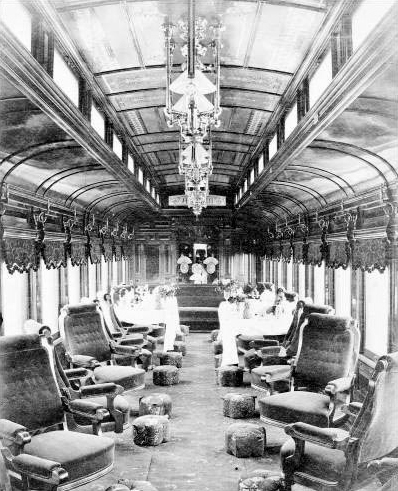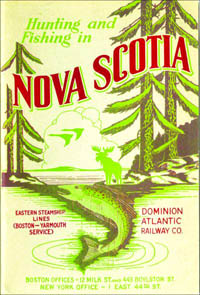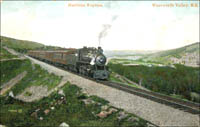
22 June 2008
Journey Through the Past

A parlour car on the Dominion Atlantic Railway, probably taken
in the 1890s.
Nova Scotia - To suggest such a trip today would be
ludicrous.
Imagine an itinerary that would have you leave Saint John, N.B., in the morning for a crossing of the Bay of Fundy, head up the Valley
for a stop in Grand Pre, continue on to Halifax for a tour of the city, then back to Annapolis Royal to catch the day's last boat to
Saint John - all without a car.
| |

Dominion Atlantic Railway published this 40-page
booklet in 1919.
|
Almost 140 years ago, before we abandoned water and rail transport in favour of ever-widening roads, that was the route
for the first ever tour group to visit Nova Scotia, a tour by 300 New Englanders scheduled for nine hours.
The completion in 1869 of rail links that connected the western Valley to Halifax made ferry service across the Bay of Fundy more
relevant and signalled the beginning of Nova Scotia's tourist industry.
A new online exhibit called Canada's Ocean Playground uses more than 6,000 photographs
and film clips, and the largest known collection of travel literature, to document the first century of tourism in the province.
"Back in the late 1800s, early 1900s, there were already hotels promoting themselves. Chambers of commerce, here in Halifax and
maybe down in Yarmouth and elsewhere, were producing little pamphlets that encouraged people to spend several days in that
community," said Lois Yorke of the Nova Scotia Archives, where the photos, films, and literature that make up the exhibit are held.
"In the 1880s, the Yarmouth Steamship Company and the Windsor and Annapolis Railway started printing promotional literature to
build ridership on the train, and the passengers coming across (from Boston) on the steamer. Instead of just people from Nova Scotia
travelling back and forth for business or pleasure, the steamship company, and then the railway, identified that you could bring
tourists in."
| |

This postcard shows a train puffing through the Wentworth
Valley in 1906. Trees obscure the view for modern-day train travellers through the
area.
|
Nine differently themed chapters make up the online exhibit. Trains and Boats and Planes has a photo from the 1890s showing the parlour
car of the Dominion Atlantic Railway.
The car featured a large chandelier, lace curtains, big stuffed armchairs, and footstools. In the background are dining tables covered
with white linens, and on each table is a big pineapple. How decadent it must have been to be served fresh pineapple in those
days.
When the White Star Line's R.M.S. Majestic visited Halifax in 1931, the vast luncheon menu on board that day included a wider variety
of seafood than is now available, and a buffet with items such as pickled lamb's tongue, boar's head, roast capon, and lamb's
sweetbreads in aspic.
In 1960, Ed Migdalski, a Yale professor, brought a team to compete in the Intercollegiate Tuna Fishing Match in Wedgeport. A photo
shows Migdalski being greeted as he gets off the plane at the Greenwood airport and being served a glass of Avon apple juice by a young
woman dressed in Nova Scotia tartan.
Scenes showing successful hunting and fishing trips from the province's early days are featured prominently in the exhibit.
From the chapter titled What Will We Do? is a shot of two hunters with their trophy, a woodland caribou taken in Victoria County in
1912.
A MacAskill photo, captioned World Record Bluefin Tuna, shows author Zane Grey with a 758-pound tuna he landed off
Liverpool in 1924.
"Some of my favourite images are of the Micmac guides in the 1880s and '90s," Yorke said.
"They are taking parties into the interior and they're camping there, they're fishing, and they're in canoes. You can see the
guides, and then there are men, basically in business suits, because that's how you went into the woods in those days.
"There are women there as well, in their long skirts - there's one image of a woman from the 1890s, and she's
fly-fishing in a long skirt, standing on a big rock."
The slogan Canada's Ocean Playground is thought to date back to around 1930.
In 1926, a promotional booklet published by the government first appeared, the predecessor to the Doers and Dreamers Guide, and by 1930
or '31, the book used the slogan Canada's Ocean Playground.
In the '30s, the cover of the booklet started to include photos of people frolicking in the ocean.
"That was when beaches were becoming popular, and outdoor vacations," said Yorke. "(They didn't) promote beaches in the
1880s; it wasn't big, women didn't go swimming then. By the '30s, they're there in their bathing suits."
The website maintained by the archives gets more than 2.5 million hits per year. Canada's Ocean Playground has only been up for a
couple of weeks, so traffic information isn't available yet.
But it is known that one person has looked at every single image - more than 6,000 of them - over several visits.
One section of the exhibit is devoted to the work of Clara Dennis, a journalist in the 1930s and considered the province's first woman
travel writer.
She drove around the province in the late '20s and early '30s, compiling a collection of more than 2,500 photographs.
"She was the first woman to take a vehicle over the Cabot Trail, when the word trail actually applied, in '28 or '29. The DOT
actually built the road in 1932," said Yorke. "She visited every nook and cranny of Nova Scotia, and she captured a province
that doesn't exist anymore."
Dennis wrote an article for the Canadian Motorist about that trip, which is part of the exhibit.
An online exhibit about the Micmac is one of the archives' most popular, as is one called Nova Scotia and the Sea, but Yorke expects
Canada's Ocean Playground, which took months of work to compile, to generate considerable interest.
"We have a small exhibit here in the lobby, just some of the more colourful items from the exhibit," she said. "You
couldn't even go through the website in a day.
"If you were to come in, we would be able to bring the materials out from the vaults but we wouldn't be very enthusiastic about
it."
|